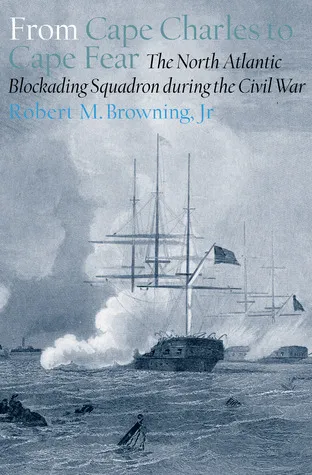From Cape Charles to Cape Fear: The North Atlantic Blockading Squadron during the Civil War
By (author): "Robert M. Browning Jr."
Publish Date:
1993
ISBN081730679X
ISBN139780817306793
AsinFrom Cape Charles to Cape Fear: The North Atlantic Blockading Squadron during the Civil War
CharactersRobert E. Lee, David Dixon Porter, Benjamin Butler, Gustavus Fox, Loui
Original titleFrom Cape Charles to Cape Fear: The North Atlantic Blockading Squadron during the Civil War
A list of U.S. naval vessels compiled in April 1861 contained only 90 names: 50 were sailing vessels, and the remaining 40 were propelled by steam. At the outbreak of the Civil War the navy had only three armed vessels ready for service on the Atlantic Coast, the remainder being either in the Gulf of Mexico or on foreign stations.President Lincoln proclaimed a blockade of Southern ports on April 19th, and on May 1st Flag Officer Silas Horton Stringham took command of the squadron blockading the Atlantic Coast from Alexandria, Virginia, to Key West, Florida. Stringham's command consisted of 14 gunboats and the Potomac Flotilla, but during the early months of the war the blockade was almost totally ineffective in restricting commerce in the coastal cities of North Carolina. Wilmington became the Confederacy's busiest port, as the navy focused attention on other Southern ports.As the war progressed Secretary of the Navy Gideon Welles oversaw the construction of a large navy powered by steam, and by war;s end the United States possessed one of the largest and most powerful navies in the world. By early 1862 most of the ports in the operational area of the North Atlantic Blockading Squadron were captured, forcing General Lee to elongate his supply line and making his army vulnerable to the success or failure of ships running the blockade. The Union armies in the eats depended upon the navy to maintain control of the interior waterways and to provide additional support services for its many military maneuvers.From Cape Charles to Cape Fear scrutinizes the North Atlantic Blockading Squadron, which operated along the coast and inland waters of North Carolina and Virginia. This is not only an operational history, but also an examination of naval logistics, tactics, and strategy. Browning shows the many external influences on the blockade and naval operations, which both enhanced and inhibited their effectiveness.In the eastern theater the navy provided the army mobility, added firepower, and solid lines of communication. The North Atlantic Blockading Squadron successfully augmented Union army operations, although it was often crippled and decimated by logistical problems caused by commitment to a wide range of duties. From the perspective of the Union navy, this study clearly presents a startling and accurate picture of the role of the blockade in Civil War military history.
